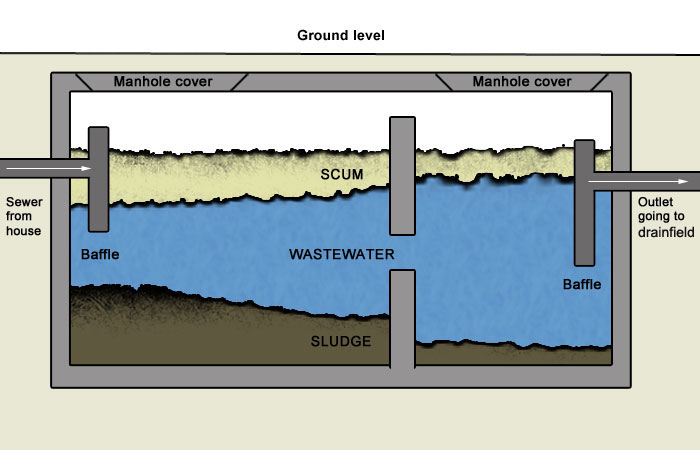Septic systems and aerated wastewater treatment systems (AWTS) are the two most common types of systems we have here in Australia. They perform similar functions but the process by which they treat wastewater is a little different and so is the quality of the effluent they produce.
Similarities between septic and AWTS
- Both rely on beneficial bacteria to treat wastewater by breaking down and digesting waste.
- Both require regular inspections to ensure they’re functioning properly and to check sludge levels.
- Both require sludge to be pumped out once it reaches a certain level.
- Both systems can be restored if they’re performing poorly.
Differences between septic and AWTS
- Septic systems don’t require electricity to operate.
- Septic systems are less complex, cheaper to install and require less maintenance.
- An AWTS uses both aerobic and anaerobic bacteria, whereas a septic system only uses anaerobic bacteria.
- AWTS produces higher quality effluent which can be used above and below ground, effluent from septic systems can only be discharged below ground and is still classed as a contaminant.
Septic systems

Traditional septic systems have been in operation for decades and they’ve changed very little over the years. Septic systems treat both greywater (water from sinks, showers and washing machines) as well as blackwater (water from toilets).
Wastewater flows into a septic tank, or series of tanks, in which solid waste is allowed to settle to be digested by beneficial bacteria. Some septic systems will have two tanks whereas other septic systems will have one tank divided into two sections. In the first tank or section solid waste settles to be digested by beneficial bacteria, the second tank or section then provides secondary treatment to further remove residual waste.
As the beneficial bacteria break down and digest the waste particles, they turn it into sludge and effluent. Sludge is what gathers at the bottom of your septic tank and needs to be pumped out and disposed of. How often you need to pump out depends on the biological conditions within your tank and the quality and quantity of your beneficial bacteria. Effluent passed into the secondary tank or section for further treatment.
The effluent is then discharged from your septic tank into an absorption trench of leach drain. This is where septic system blockages most commonly occur when there are insufficient beneficial bacteria to effectively digest waste and particles pass through the system and clog the leach drain.
Aerated Wastewater Treatment Systems

Aerated wastewater treatment systems (AWTS) are a newer type of system which incorporate an aeration and disinfection stage to further treat wastewater. AWTS are similar to septic systems in that they treat both greywater and blackwater, and the first section is used to settle solids to be broken down and digested by beneficial bacteria.
The second section onwards is where AWTS are different. An AWTS second section mixes the partially treated wastewater with air to help the beneficial bacteria further break down waste. A third section then allows any solids to further settle and a fourth section disinfects effluent before it is discharged, usually into surface or subsurface irrigation.
The effluent from an AWTS is of a better standard than effluent from a septic system and is why it can be used for irrigation.
To find out more about how we can guarantee your septic or AWTS system gets back to peak performance, please get in touch with us. Here are what some of our happy, long-term customers are saying.
We have been using the product for over 15 years in our septic system and have had our system pumped out once in all that time and were told our system was the cleanest they had ever had to service.
Gerry Kelly
I love it, I clean everything with it. We have been using it for 11 years and only pumped out once, we where told it was so healthy.
Michelle Wright
We have two septic systems, both treated with EcoCare. Systems have remained trouble free and have not required to be pumped out since we started using the product 12 years ago.. An excellent product.
Bryant Ham
Provides the result that we hope for quickly and easily. No mess, no fuss, no smell, in fact the smell from our grease trap disappears. Our system has not been pumped out a decade or more.
Larry Greetham
